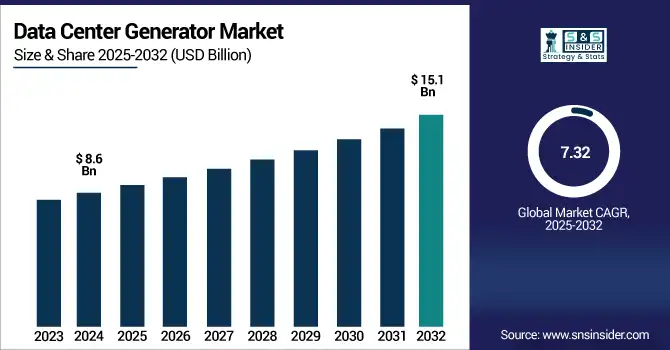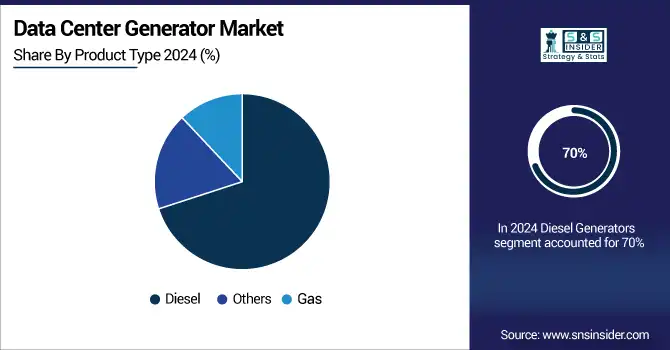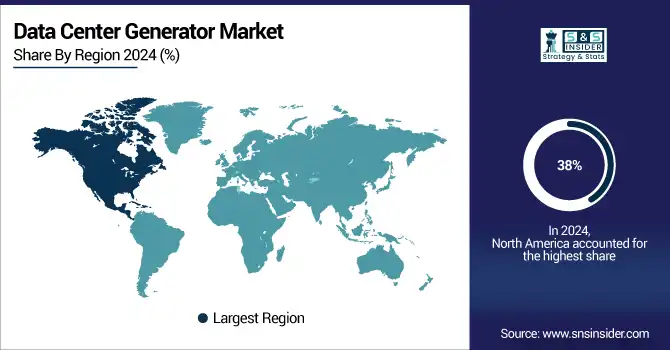Data Center Generator Market Report Scope & Overview:
The Data Center Generator Market size was valued at USD 8.6 billion in 2024 and is expected to reach USD 15.1 billion by 2032, growing at a CAGR of 7.32% during 2025-2032.

To Get more information on Data Center Generator Market - Request Free Sample Report
With the demand for continuous power in hyper-scale and colocation data centers, driving the growth of the data center generator market. Their market growth is also being driven by the increase in data traffic, cloud computing, and digital transformation of industries. Some of the Key data center generator market Trends are eco-friendly gas generators, renewable energy sources integration, and edge data center deployment. The diesel generators are still in the foreground, but the hybrid ones are gaining ground.
Rising dependency on AI, IoT, and 5G infrastructure based on high uptime is expected to be a major driving factor. Data center generator market analysis delivers an illuminating overview of the changing landscape of scalable, efficient backup systems and ensures the continuity of operation of mission-critical operations amid base power grid outages and strict data compliance requirements.
The demand for continuous power supply in hyperscale and colocation data centers will propel the U.S. data center generator market growth. market was valued USD 2.59 billion in 2024 and will register a CAGR of 6.99% during the forecast period, reaching USD 4.43 billion in 2032.
Market Dynamics:
Drivers:
-
Growing Demand for Data Reliability Drives Surge in Backup Generator Investments
The growing usage of data globally and increased dependency on cloud computing have raised the demand for high-availability data centers. Generators are essential for backup power to operations, especially during extended outages. As enterprises transition toward a hybrid and multi-cloud infrastructure and internet activity surges with IoT and streaming services, the need for continuous uptime has become an imperative. Consequently, data centre operators are spending a huge amount on diesel and gas generators to prevent any downtime, which would cause revenue loss and data disruption. A key driver for the data center generator market is the rising need for dependable and efficient backup solutions.
In the year leading up to September 2024, Siemens's data-center business experienced a 60% increase in orders, totalling over USD 4.0 billion, and a 50% rise in revenue, surpassing USD 2.2 billion.
Restraints:
-
Strict Environmental Regulations Curb Diesel Generator Adoption
The most common restraint on the data center generator market is stringent environmental regulations pertaining to carbon emissions, especially for diesel-powered generators. Shortages of traditional fossil fuel backup power solutions are expected as governments and environmental agencies demand energy alternatives. Operators face high compliance costs in regions where emissions standards tighten so that they will have to either adopt cleaner, and likely costly alternatives, such as hydrogen or battery backup systems, or risk being weeded out.
Besides, growing pressure from society toward carbon footprint reduction may dissuade companies from investing in diesel generators and thus, restrain the market growth over the forecast period. Particularly, these environmental constraints require an evolution from brown to green technologies, but add complexity to purchase and operating decisions.
For instance, in 2023, the Indian government implemented the CPCB IV+ emission standards for diesel generators up to 800 kW, achieving a 90% reduction in particulate matter and nitrogen oxide emissions compared to previous norms.
Opportunities:
-
Expansion of Hyperscale and Edge Data Centers Boosts Generator Demand
With the large-scale expansion of hyperscale data centers by the leading cloud providers, and the fast emergence of edge data centers driving the demand for latency-sensitive applications, the growth in the generator market has a major potential to seize.' Data centers need backup power, predicated on high reliability and scalability, along with a modular design.
Industries set to adopt AI, 5G, and real-time data analytics will create a need for distributed computing, which in turn will push demand for edge facilities in both remote and urban locations, and each of them will require solid backup systems. Indeed, this changing ecosystem presents generator manufacturers, especially those with efficient, low-maintenance, environmentally compliant, cost-effective solutions, with an opportunity for new revenue streams as they cater to next-generation data centres.
Challenges:
-
Shift Toward Green Energy Solutions Challenges Conventional Generator Market
The worldwide transition towards greener energy has been challenging the traditional generator market, which largely functions on diesel fuel-powered systems. Renewable energy systems combined with Battery Energy Storage Systems (BESS) are a greener, quieter, and often more affordable long-term solution that seamlessly fits with data centers, which are increasingly turning to them. Improvements in lithium-ion batteries and falling prices make these options increasingly attractive.
Also, at the outset to become carbon neutral, firms are focusing on green solutions, which are reducing the demand for traditional generator sets. This means that generator manufacturers will adapt or die. Against that background, the industry's old hands have a daunting set of challenges, to ensure reliability and environmental compliance at a reasonable cost.
For Instance, in 2024, data centers led global clean energy procurement, contracting over 17 GW, surpassing all other sectors.
Segmentation Analysis:
By Product Type:
The diesel generators segment dominated the market and accounted for 70% of the data center generator market share in 2024. Due to their great performance, quick start-up, and reliability when certain loads are high. In hyperscale data centers, these is common to provide uptime continuity during power failures. Despite pressure from environmentalists, their existing infrastructure and reliability will keep demand high for fuel. They will continue their leadership for the next few years due to their cleaner diesel technology innovations.
The gas generators segment is expected to register the fastest CAGR during the forecast period, driven by emissions and operational cost benefits, and better regulatory positioning than diesel. They are becoming more popular in new sustainable data centers. Adopting green infrastructure globally and ever-increasing accessibility and affordability of natural gas will create rapid growth, specifically in areas with strong environmental regulations and carbon reduction targets.

By Capacity:
The <1 MW segment dominated the data center generator market and accounted for 54% of revenue share in 2024, as these are the preferred choice for edge and small to mid-sized data centers in urban and developing regions. These generators provide the most cost-effective and compact solutions for low-capacity backup power needs in a smaller footprint. The demand for sub-1 MW generators will continue to grow due to the expansion of distributed IT infrastructure and micro data centers, especially in the telecom and retail industries.
The segment 1 MW–2 MW is expected to grow at the fastest CAGR during the forecast period, as the medium-scale enterprise data centers and colocation facilities will be installed in the same capacity range. Such generators offer a performance vs. cost ratio perfect for a scalable IT infrastructure. This segment is expected to see a phenomenally high growth due to the rising requirement of modular data centers and hybrid clouds in the prediction period.
By Tier Standards:
The Tier III data center segment dominated the data center generator market in 2024 and accounted for a significant revenue share, due to its cost-effectively than Tier IV. They are extremely common among enterprises and colocation providers who are weighing price against reliability. Ultimately, the increase in need for a scalable and resilient infrastructure due to hastened digital transformation is expected to propel the growth of Tier III deployments in both developed and emerging geographies.
The Tier IV segment is expected to register the fastest CAGR during the forecast period, which accounts for mission-critical applications' uptime and a fault-tolerant architecture. Sectors such as banking, healthcare, and hyperscale cloud providers now invest more in Tier IV data centers. As cyber threats grow and the appetite for service-level expectations rises, this market will grow quickly in parts of the world where infrastructure reliability and operational continuity take precedence.
Regional Analysis:
North America dominated the data center generator market and accounted for 38% of revenue share in 2024. The presence of the largest hyperscale data centers, along with the reason for early cloud adoption in North America, and the presence of tech giants, such as AWS, Microsoft, and Google. The need for generators remains stable, due to high data consumption, well-developed infrastructure, and continuous updating. Further investment in AI, 5G, and edge computing will help to maintain regional dominance in the years to come.
Driven by rapid digital transformation, rising internet penetration rates, and the rapid adoption of cloud services, Asia-Pacific is expected to register the fastest CAGR during the forecast period. Increased need for generators has been fueled by Government smart city projects, growing hyperscale facilities, and expanding telecom market. The demand for backup power will rise sharply as regional economies continue to digitize.
With huge investments in cloud infrastructure, rapid expansion of data centers, and government support in digitalisation, China leads the Asia-Pacific data center generator market. The growth is attributed to the increasing adoption of AI, industrial automation, and national data security projects for high-reliability backup power systems.
The combination of highly restrictive data protection laws, increased colocation demand, and infrastructure upgrades driven by sustainability initiatives powered the majority of Europe’s growth. Demand for low-carbon emitters is expected to remain as green power regulation continues to tighten, and the expansion of edge data centres to enable smart cities and digital transformation across the continent.
Germany dominated the European data center generator market, owing to the presence of large industrial and manufacturing sectors, the existing strong IT infrastructure, and the need for secure data storage. Inexpensive and energy-efficient generators will continue to be adopted in order to ensure secure backup in a promising market for low-cost and efficient power generation plants for colocation services and at hyperscale architectures, moving forward, with regulatory requirements demanding energy efficiency.

Get Customized Report as per Your Business Requirement - Enquiry Now
Key Players:
The major data center generator market companies are Caterpillar, Cummins, Kohler, Generac Power Systems, MTU Onsite Energy (Rolls-Royce), Mitsubishi Heavy Industries, Atlas Copco, Himoinsa, FG Wilson, DEUTZ AG and others
Recent Developments:
-
In February 2025, Generac announced the launch of high-capacity standby generators tailored for hyperscale data centers in the U.S. These diesel-powered units, ranging from 2.25 to 3.25 megawatts, aim to meet the escalating demand for robust backup power solutions in large-scale data centers. Manufactured at Generac's Oshkosh facility, the first shipments are scheduled for late 2025.
-
In November 2024, Rolls-Royce supplied ten mtu 20V 4000 L64 FNER gas generator sets for a distributed energy project in Alberta, Canada. These generators, designed to provide reliable power during peak demand, underscore the company's commitment to sustainable energy solutions in data center applications.
| Report Attributes | Details |
|---|---|
| Market Size in 2024 | US$ 8.6 Billion |
| Market Size by 2032 | US$ 15.1 Billion |
| CAGR | CAGR of 7.32% From 2024 to 2032 |
| Base Year | 2024 |
| Forecast Period | 2024-2032 |
| Historical Data | 2021-2023 |
| Report Scope & Coverage | Market Size, Segments Analysis, Competitive Landscape, Regional Analysis, DROC & SWOT Analysis, Forecast Outlook |
| Key Segments | • By Product Type (Diesel, Gas, Others) • By Capacity (<1 MW, 1–2 MW, >2 MW) • By Tier Standards (Tier I & II, Tier III, Tier IV) |
| Regional Analysis/Coverage | North America (US, Canada, Mexico), Europe (Germany, France, UK, Italy, Spain, Poland, Turkey, Rest of Europe), Asia Pacific (China, India, Japan, South Korea, Singapore, Australia, Rest of Asia Pacific), Middle East & Africa (UAE, Saudi Arabia, Qatar, South Africa, Rest of Middle East & Africa), Latin America (Brazil, Argentina, Rest of Latin America) |
| Company Profiles | Caterpillar, Cummins, Kohler, Generac Power Systems, MTU Onsite Energy (Rolls-Royce), Mitsubishi Heavy Industries, Atlas Copco, Himoinsa, FG Wilson, DEUTZ AG and others in the report |

